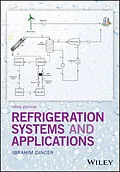The definitive text/reference for students, researchers and practicing engineers
This book provides comprehensive coverage on refrigeration systems and applications, ranging from the fundamental principles of thermodynamics to food cooling applications for a wide range of sectoral utilizations. Energy and exergy analyses as well as performance assessments through energy and exergy efficiencies and energetic and exergetic coefficients of performance are explored, and numerous analysis techniques, models, correlations and procedures are introduced with examples and case studies. There are specific sections allocated to environmental impact assessment and sustainable development studies. Also featured are discussions of important recent developments in the field, including those stemming from the author's pioneering research.
Refrigeration is a uniquely positioned multi-disciplinary field encompassing mechanical, chemical, industrial and food engineering, as well as chemistry. Its wide-ranging applications mean that the industry plays a key role in national and international economies. And it continues to be an area of active research, much of it focusing on making the technology as environmentally friendly and sustainable as possible without compromising cost efficiency and effectiveness.
This substantially updated and revised edition of the classic text/reference now features two new chapters devoted to renewable-energy-based integrated refrigeration systems and environmental impact/sustainability assessment. All examples and chapter-end problems have been updated as have conversion factors and the thermophysical properties of an array of materials.
* Provides a solid foundation in the fundamental principles and the practical applications of refrigeration technologies
* Examines fundamental aspects of thermodynamics, refrigerants, as well as energy and exergy analyses and energy and exergy based performance assessment criteria and approaches
* Introduces environmental impact assessment methods and sustainability evaluation of refrigeration systems and applications
* Covers basic and advanced (and hence integrated) refrigeration cycles and systems, as well as a range of novel applications
* Discusses crucial industrial, technical and operational problems, as well as new performance improvement techniques and tools for better design and analysis
* Features clear explanations, numerous chapter-end problems and worked-out examples
Refrigeration Systems and Applications, Third Edition is an indispensable working resource for researchers and practitioners in the areas of Refrigeration and Air Conditioning. It is also an ideal textbook for graduate and senior undergraduate students in mechanical, chemical, biochemical, industrial and food engineering disciplines.
Autorentext
Ibrahim Dincer, PhD, is a full professor of Mechanical Engineering in the Faculty of Engineering and Applied Science at UOIT and a leading authority in the area of sustainable energy systems, including refrigeration systems and applications. He is Vice President for Strategy in International Association for Hydrogen Energy (IAHE) and Vice-President for World Society of Sustainable Energy Technologies (WSSET). Renowned for his pioneering works in the area of sustainable energy technologies, Professor Dincer has authored and co-authored numerous books and book chapters, more than a thousand refereed journal and conference papers, and many technical reports. He has chaired many national and international conferences, symposia, workshops and technical meetings and has delivered more than 300 keynote and invited lectures. Professor Dincer is an active member of various international scientific organizations and societies, and serves as editor-in-chief, associate editor, regional editor, and editorial board
member on various prestigious international journals. He is a recipient of several research, teaching and service awards, including the Premier's research excellence award in Ontario, Canada, in 2004. Professor Dincer has made innovative contributions to the understanding and development of sustainable energy technologies and their implementation. He has actively been working in the areas of hydrogen and fuel cell technologies, and his group has developed various novel technologies/methods, etc. Furthermore, he has been recognized by Thomson Reuters as one of the World's Most Influential Scientific Minds in Engineering in 2014, 2015 and 2016.
Inhalt
Preface xvii
Acknowledgments xix
1 General Aspects of Thermodynamics 1
1.1 Introduction 1
1.2 Dimensions and Units 2
1.2.1 Systems of Units 2
1.3 Thermodynamics 9
1.4 Ideal and Real Gases 30
1.5 Refrigerators and Heat Pumps 36
1.6 Psychrometrics 49
1.7 Concluding Remarks 64
Nomenclature 64
Study Problems 67
References 70
2 Refrigerants 71
2.1 Introduction 71
2.2 Classification of Refrigerants 72
2.3 Prefixes and Decoding of Refrigerants 76
2.4 Secondary Refrigerants 79
2.5 Refrigerantabsorbent Combinations 80
2.6 Stratospheric Ozone Layer 82
2.7 Global Warming 89
2.8 Clean Air Act 94
2.9 Key Refrigerants 103
2.10 Selection of Refrigerants 115
2.11 Thermophysical Properties of Refrigerants 116
2.12 Lubricating Oils and their Effects 120
2.13 Concluding Remarks 122
Study Problems 122
References 125
3 Refrigeration SystemComponents 127
3.1 Introduction 127
3.2 History of Refrigeration 128
3.3 Main Refrigeration Systems 130
3.4 Refrigeration System Components 131
3.5 Compressors 132
3.6 Condensers 156
3.7 Evaporators 165
3.8 Throttling Devices 172
3.9 Auxiliary Devices 177
3.10 Concluding Remarks 180
Nomenclature 180
Study Problems 182
References 187
4 Refrigeration Cycles and Systems 189
4.1 Introduction 189
4.2 Vapor-compression Refrigeration Systems 189
4.3 Energy Analysis of Vapor-compression Refrigeration Cycle 192
4.4 Exergy Analysis of Vapor-compression Refrigeration Cycle 195
4.5 Actual Vapor-compression Refrigeration Cycle 200
4.6 Air-standard Refrigeration Systems 210
4.7 Absorption Refrigeration Systems 216
4.8 Concluding Remarks 245
Nomenclature 245
Study Problems 247
References 258
5 Advanced Refrigeration Cycles and Systems 261
5.1 Introduction 261
5.2 Multistage Refrigeration Cycles 262
5.3 Cascade Refrigeration Systems 268
5.4 Multi-effect Absorption Refrigeration Systems 280
5.5 Steam-jet Refrigeration Systems 311
5.6 Adsorption Refrigeration 317
5.7 Stirling Cycle Refrigeration 322
5.8 Thermoelectric Refrigeration 328
5.9 Thermoacoustic Refrigeration 332
5.10 Metal Hydride Refrigeration 334
5.11 Magnetic Refrigeration 337
5.12 Supermarket Refrigeration Practices 345
5.13 Concluding Remarks 349
Nomenclature 349
Study Problems 351
References 354
6 Renewable Energy-based Integrated Refrigeration Systems 357
6.1 Introduction 357
6.2 Solar-powered Absorption Refrigeration Systems 358
6.3 Solar-powered Vapor-compression Refrigeration Systems 364
6.4 Wind-powered Vapor-compression Refrigeration Systems 368
6.5 Hydropowered Vapor-compression Refrigeration Systems 371
6.6 Geothermal-powered Vapor-compression Refrigeration Systems 375
6.7 Ocean Thermal Energy Conversion Powered Vapor-compression Refrigeration Systems 379
6.8 Biomass-powered Absorption Refrigeration Systems 383
6.9 Concluding Remarks…
